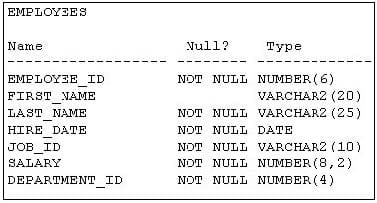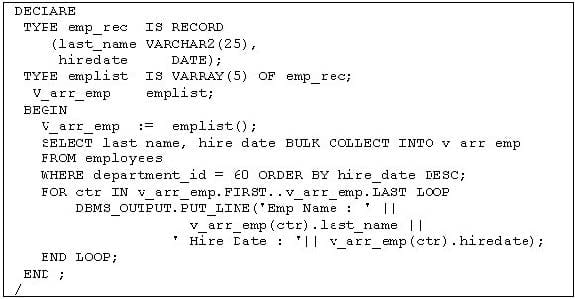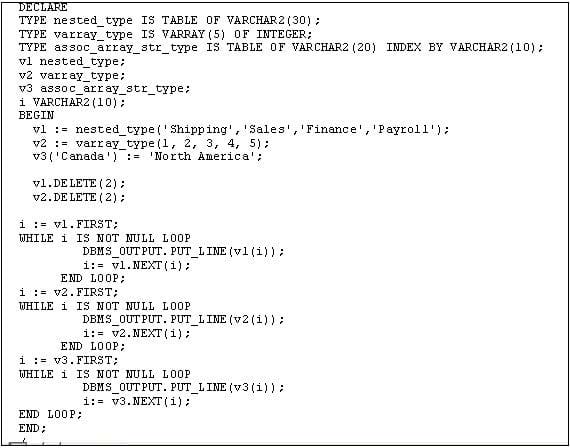Exam Details
Exam Code
:1Z0-148Exam Name
:Oracle Database: Advanced PL/SQLCertification
:Oracle CertificationsVendor
:OracleTotal Questions
:243 Q&AsLast Updated
:Jun 28, 2025
Oracle Oracle Certifications 1Z0-148 Questions & Answers
-
Question 221:
View Exhibit1 and examine the structure of the EMPLOYEES table.
View the Exhibit2 and examine the PL/SQL block that you execute for displaying the last name and hire date of the employees in department ID 60.
Which statement is true about the outcome?


A. It generates an error because RECORD type cannot be used with varrays.
B. It generates an error because BULK COLLECT cannot be used with varrays.
C. It executes successfully only if department ID 60 has five or less than five employees.
D. It executes successfully even if department ID 60 has more than five employees by dynamically extending the varray.
-
Question 222:
Which three actions can be performed by using the DBMS_ASSERT package to prevent SQL injection? (Choose three.)
A. Detect a wrong user.
B. Check input string length.
C. Verify qualified SQL names.
D. Validate TNS connect strings.
E. Verify an existing schema name.
F. Enclose string literals within double quotation marks.
-
Question 223:
Examine the structure of the TEST_DETAILS table: Name Null? Type
TEST_ID NUMBER
DESCRIPTION CLOB
DESCRIPTION data was entered earlier and saved for TEST_ID 12.
You execute this PL/SQL block to add data to the end of the existing data in the DESCRIPTION column for
TEST_ID 12:
DECLARE
clob_loc CLOB;
buf CHAR(12);
BEGIN
SELECT description INTO clob_loc FROM test_details WHERE test_id = 12 ;
buf := '0123456789';
DBMS_LOB.WRITEAPPEND(clob_loc,DBMS_LOB.GETLENGTH(buf), buf);
COMMIT;
END;
/
It generates an error on execution.
What correction should you do to achieve the required result?
A. WRITEAPPEND must be replaced with APPEND.
B. The BUF variable data type must be changed to CLOB.
C. FOR UPDATE must be added to the SELECT statement.
D. The GETLENGTH routine must be replaced with the LENGTH built-in function in WRITEAPPEND.
-
Question 224:
View the Exhibit and examine the code in the PL/SQL block.
The PL/SQL block generates an error on execution. What is the reason?

A. The DELETE(n) method cannot be used with varrays.
B. The DELETE(n) method cannot be used with nested tables.
C. The NEXT method cannot be used with an associative array with VARCHAR2 key values.
D. The NEXT method cannot be used with a nested table from which an element has been deleted.
-
Question 225:
You issue the following command to create the PRINT_MEDIA table.
CREATE TABLE print_media
(product_id NUMBER(3),
ad_sourcetext CLOB,
ad_photo BLOB);
Evaluate the following INSERT statements:
INSERT INTO print_media VALUES (1, empty_clob(),empty_blob());
INSERT INTO print_media VALUES (2,'This is a One Line Story',null);
INSERT INTO print_media VALUES (3,'This is another One Line Story',empty_blob());
INSERT INTO print_media VALUES (4,empty_clob(),to_blob('This is new Story'));
Which of the above INSERT statements are valid?
A. Only the first statement is valid.
B. All the statements are valid.
C. Only the first and fourth statements are valid.
D. Only the first and second statements are valid.
E. Only the first, second and third statements are valid.
-
Question 226:
Which two statements correctly describe the features of SecureFiles? (Choose two.)
A. Compression is performed only on the server side and enables random reads and writes to LOB data.
B. Deduplication stores identical data, which occurs in a LOB column in each row, as a single copy within the LOB.
C. Compression can be performed on the client side and it enables random and sequential reads and writes to LOB data.
D. Deduplication stores identical data occurring two or more times in the same LOB column as a single copy for the table.
-
Question 227:
You created a PL/SQL subprogram that successfully invokes an external C procedure. After a while, the database administrator (DBA) drops the alias library schema object. The shared library exists in the system. Which statement is true in this scenario?
A. The corresponding shared library is also removed from the system.
B. PL/SQL subprograms can be used to invoke the external C procedure.
C. The existing extproc process is terminated and a new extproc is started.
D. The PL/SQL subprogram that depends on the external C program becomes invalid.
-
Question 228:
Examine the PL/SQL code for the GET_TABLE_MD function given below:
CREATE OR REPLACE FUNCTION get_table_md RETURN CLOB IS
h NUMBER;
th NUMBER;
doc CLOB;
BEGIN
h := DBMS_METADATA.OPEN('TABLE');
DBMS_METADATA.SET_FILTER(h,'SCHEMA','HR');
DBMS_METADATA.SET_FILTER(h,'NAME','TIMECARDS');
th := DBMS_METADATA.ADD_TRANSFORM(h,'DDL');
doc := DBMS_METADATA.FETCH_CLOB(h);
DBMS_METADATA.CLOSE(h);
RETURN doc;
END;
Which statement is true about the compilation and execution of the function?
A. The function retrieves the metadata in Extensible Markup Language (XML) format for creating the TIMECARDS table in the HR schema.
B. The compilation produces an error because DBMS_METADATA.SET_FILTER(h,'SCHEMA','HR')is not placed in the correct order.
C. The function retrieves the metadata as a data definition language (DDL) statement for creating the TIMECARDS table in the HR schema.
D. The execution of the function produces an error because multiple objects are fetched and DBMS_METADATA.FETCH_CLOB is not called in a LOOP.
-
Question 229:
Which statements are true about internal LOBs? (Choose all that apply.)
A. They cannot use redo logging.
B. They can be used as attributes of a user-defined data type.
C. They cannot be passed as parameters to PL/SQL subprograms.
D. They can be stored in a tablespace that is different from the tablespace that stores the table containing the LOB column.
-
Question 230:
Examine the code in the following PL/SQL block:
DECLARE
TYPE NumList IS TABLE OF INTEGER;
List1 NumList := NumList(11,22,33,44);
BEGIN
List1.DELETE(2);
DBMS_OUTPUT.PUT_LINE
( 'The last element# in List1 is ' || List1.LAST ||
' and total of elements is '||List1.COUNT);
List1.EXTEND(4,3);
END;
/
Which two statements are true about the above code? (Choose two.)
A. LAST and COUNT give different values.
B. LAST and COUNT give the same values.
C. The four new elements that are added contain the value 33.
D. The four new elements that are added contain the value 44.
Related Exams:
1Z0-020
Oracle8i: New Features for Administrators1Z0-023
Architecture and Administration1Z0-024
Performance Tuning1Z0-025
Backup and Recovery1Z0-026
Network Administration1Z0-034
Upgrade Oracle9i/10g OCA to Oracle Database OCP1Z0-036
Managing Oracle9i on Linux1Z0-041
Oracle Database 10g: DBA Assessment1Z0-052
Oracle Database 11g: Administration Workshop I1Z0-053
Oracle Database 11g: Administration II
Tips on How to Prepare for the Exams
Nowadays, the certification exams become more and more important and required by more and more enterprises when applying for a job. But how to prepare for the exam effectively? How to prepare for the exam in a short time with less efforts? How to get a ideal result and how to find the most reliable resources? Here on Vcedump.com, you will find all the answers. Vcedump.com provide not only Oracle exam questions, answers and explanations but also complete assistance on your exam preparation and certification application. If you are confused on your 1Z0-148 exam preparations and Oracle certification application, do not hesitate to visit our Vcedump.com to find your solutions here.